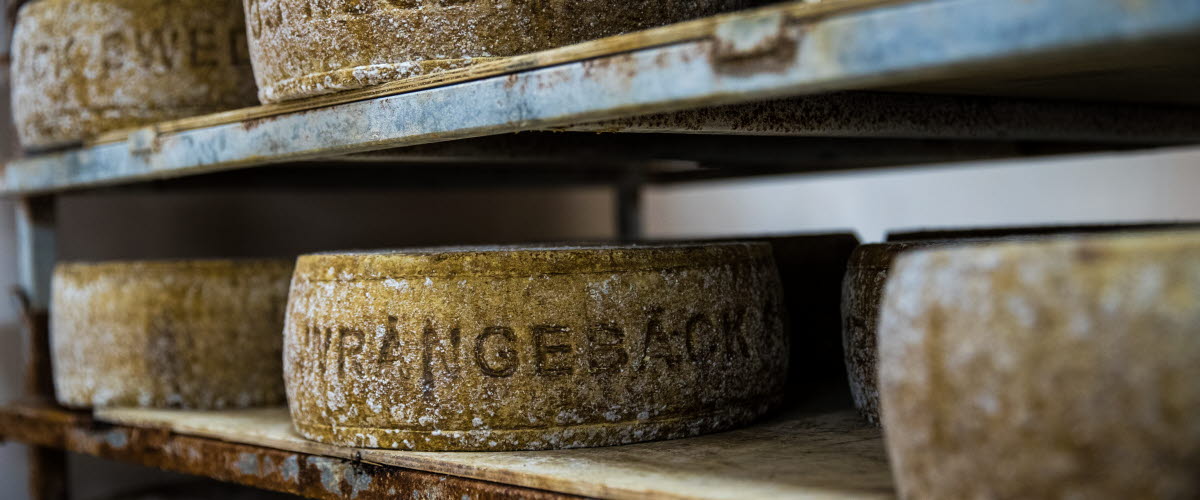Award-Winning Cheese from Almnäs
The prize-winning Wrångebäck cheese received Protected Designation of Origin (PDO) status in 2022. The cheese is produced at Almnäs Bruk, one of the largest organic farms in the Nordic region, with roots dating back to the Middle Ages.
🧀 An Award-Winning Classic
Wrångebäck is a traditional Swedish hard cheese made using the same recipe that was used at Almnäs as far back as the 1880s – a practice that continued until 1961. In older literature, Wrångebäck was referred to as the prototype for what later became known as “large-eyed Herrgårdsost”.
Since 2022, Wrångebäck has enjoyed PDO status, placing it alongside culinary icons such as Champagne and Parma ham.
In 2018, Wrångebäck also took home a Silver medal at the World Cheese Awards in Bergen, Norway.
🛡️ What is Protected Designation of Origin (PDO)?
To be granted PDO status, the raw material, processing, and production must all take place within a clearly defined geographic area. For Wrångebäck, this area is known as Guldkroksbygden, a stretch of land along the shores of Lake Vättern.
PDO status also means that there is now an official definition of what qualifies as a true Wrångebäck cheese. Everything from its weight, aroma, and taste to texture and nutritional content is documented and forms the basis for that definition.
🧾 About Wrångebäck Cheese
The trademark “Wrångebäck Sweden”, now stamped onto the side of each wheel, was registered on 8 April 1889 – making it the oldest registered cheese brand in Sweden.
After a 47-year break in production, the cheese returned thanks to the help of Hans Stiller, the former dairy master at Almnäs Bruk, then 82 years old. He helped reconstruct the recipe, even using shelving from the old dairy to transfer the original bacterial cultures, which had survived in the wood. This preserved an unbroken chain of microbial heritage going back at least 150 years.
Each wheel of Wrångebäck weighs approximately 8 kg and has a diameter of 31 cm. Until 1961, the cheese was wax-coated, but today it is made with a washed rind, just like its sibling cheese Almnäs Tegel.
Its aroma is gently tangy, evoking notes of milk and warm barn hay. The flavour is complex with hints of umami, and the texture is tender with a characteristic crunch. Ageing time: 10–15 months.
📖 A Cheese with a Rich History
There are many stories tied to Wrångebäck’s long legacy. For example:
-
It was served at the farewell dinner for engineer Andrée and his companions before their polar expedition to Svalbard in 1896.
-
It was featured at the 500th anniversary of Sweden’s first parliament in 1935.
-
It was also part of a charity event in Hagaparken, organised by Princess Sibylla.
🛒 Where to Buy the Cheese
Wrångebäck can be found in select locations across Sweden – and abroad. It’s also a favourite among chefs at restaurants around the country. If you’d like to buy it locally in Hjo, visit the self-service farm shop just outside the dairy at Almnäs Bruk.
🏡 About Almnäs Bruk
Almnäs is a historic estate with roots tracing back to the Middle Ages. It was first mentioned in a parchment charter related to the Older Westrogothic Law, dated 14 August 1225. It describes how monks from Alvastra Abbey met with local chiefs to establish the boundaries of what would become Almnäs.
From the Middle Ages until 1527, Almnäs belonged to Alvastra Abbey. During the Reformation, Gustav Vasa brought the estate under the Crown, and in 1587, Margareta Axelsdotter Natt och Dag merged twelve farms into what is essentially Almnäs as we know it today.
Over the centuries, Almnäs has been owned by several noble families – among the most influential were the Sparre, Posse, Stackelberg and Dickson families. Since 1915, the estate has been owned by the Berglund family.



